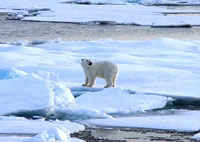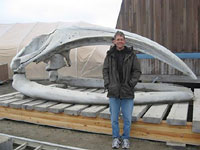

 | |||||||||||||||||||||
|
|
Journals 2008/2009Steve Howard
August 23, 2008 I woke up this morning to find out that the night watch saw a polar bear at about 5am. Trying to hide my jealousy, I spent the next two hours up on the bridge scanning for bears, but no luck. We have hit an area of thick ice, with many floes four to six feet thick at the water line and remnants of pressure ridges that are thrust above the ice another eight feet or so. This is a good environment for bears, and everyone is keeping their cameras handy in the event one happens to be spotted. I've heard that last year at this same time fourteen bears were spotted, and at about halfway through our cruise we've only seen one. I did see a few fresh tracks of bears, though. Well, it's something!
Because of the polar bear sighting, I thought I'd dedicate today's journal entry to describing a few of the key marine mammal species in this region of the Arctic. I'm no expert on this topic, but I've located some books to help me out. I've also asked George, the community observer from Barrow who I profiled earlier, to check it over for me, as he has a great knowledge of these animals. Thanks, George! The top predator around here is, of course, the polar bear. These guys can get enormous, up to 1800 pounds, and their principal prey are ringed seals, which they sniff out and excavate from their birthing lairs or stalk near the seal's breathing holes in the ice. Polar bears are powerful swimmers, and can swim 60 miles or more in open water. On open ice, they can run as fast as 30 mph! George says that in Barrow it is not uncommon to see three or four bears foraging on the beaches. When science teams deploy on the ice, Coast Guard crew go down with guns in case a polar bear is around. The Inupiats have an agreement with the federal government allowing subsistence hunting of polar bears, which they use for food and fur. Other than that, there is no commercial hunting of polar bears. There is much concern about the future of polar bears; with thinning ice due to climate change, there will be less seal pupping sites and therefore less for the polar bears to eat.
Though there are a number of seal species in the Arctic Ocean, ringed seals are the most common. They can weigh up to 240 pounds and measure about five feet long when fully grown and have dark grey bodies with scattered irregular rings. Ringed seals will dig out lairs in and under sea ice to have their pups and avoid predation. Their primary food is cod, and they regularly dive hundreds of feet down for seven minutes to hunt. Ringed seals are an important subsistence prey for native arctic communities along the North Slope. Walruses live in relatively shallow water near the coast, so it is not likely we would see one as far out as we are now. They get 12 ft long and weigh up to 4,000 pounds. Walruses use their tusks primarily for social interactions, such as when males compete for females during breeding, and to help haul up on the ice. Walruses feed mainly on mollusks and other invertebrates on the shallow seafloor. Bowhead whales are well adapted to Arctic Ocean conditions, with a layer of blubber up to 1 1/2 feet thick and a huge head that can break through thick ice, where they reside for much of the year. Bowhead whales are "skim feeders," filtering krill and a wide variety of invertebrates with their baleen. Bowhead whales were the target of intensive whaling in the pre-modern era, however the population in the Chukchi sea area is still relatively strong. The hunting of bowhead whales, and also beluga whales, by the people of Barrow is important not only for food but also for their cultural heritage and pride. George was kind enough to talk to me a little bit about Inupiat hunting practices. All of the animals I've mentioned here are an essential part of their subsistence diet as well as their cultural identity. The meat from these animals is shared with all members of the Barrow community according to need, and the blubber is rendered down into oil that is used to season their food. The meat is stored in ice cellars dug deep into the permafrost. Hunting parties may be gone for weeks at a time, and those chosen are recognized for their experience and skill. How often they hunt and when they hunt is determined by season, migration routes, and principally by the need for food within the community. I had a chance to visit a museum in Barrow before coming on the Healy, and there were fantastic exhibits on traditional as well as current subsistence hunting practices by the Inupiat of the North Slope.
|
||||||||||||||||||||




